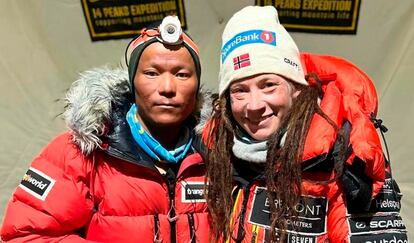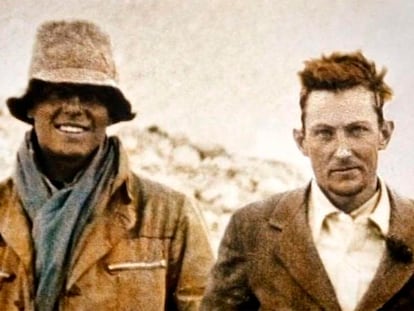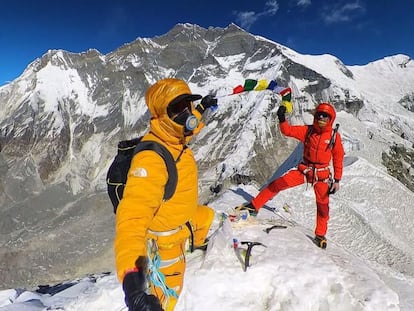Kristin Harila and ‘empty records’
Accompanied by Tenjen Lama Sherpa, the Norwegian has ascended the 14 eight-thousanders in 92 days, but the feat will leave little trace in the history of mountaineering

To ask about the importance of the so-called records of the present in the world of mountaineering, there is no better response than to visit the great mountaineers of the past, those who can only view the vast economic and material means of today with wide eyes. Sitting in the cable car that descends to Gressoney, Italy, from the Monte Rosa massif, Arturo Squinobal, 78, proudly wears his guide’s badge. He has just completed, together with a friend, 2,000 meters of vertical drop and as many meters of ascent and looks serene and sharp, although he clarifies that he has not been guiding: “I am retired, I only accompany friends. I still love the mountains.” Squinobal was one of the heroes who in 1972 made the first winter ascent of the Peuterey Integral, more than 4,000 meters of rock, ice, and mixed climbing to reach the summit of Mont Blanc. He was accompanied by his brother Oreste and they ended up joining a French team consisting of Louis Audoubert, a priest and great mountaineer, Marc Galy, the legendary Yannick Seigneur, and Michel Feuillarade. “We were up there for several days, we spent almost all of Christmas on the ridge,” recalls Squinobal. And what does he think of Benjamin Védrines’ recent summer ascent on the same stage, in a mere 6 hours and 51 minutes? “I think he didn’t carry a 20-kilogram backpack like us,” he says and bursts out laughing, patting his thigh with a huge hand, almost a claw accustomed to grasping rock. “Védrines is from another galaxy,” he says admiringly, “because it is mountaineering without cheating... nothing to do with what is happening in the eight-thousanders right now, with empty records,” says the veteran Italian guide.
And it is here that the cases of the Nepalese Nirmal Purja and the Norwegian Kristin Harila warrant mention: the former climbed the planet’s 14 eight-thousanders in six months and six days, although the feat was invalidated when it was discovered that she was missing at least a couple of summits. Harila was determined to improve on Purja’s achievement and has just smashed the record, claiming all 14 peaks in 92 days, always hand-in-hand with the Nepalese Tenjen Lama Sherpa. The media noise has been considerable: so much cacophony to leave so little in the history of mountaineering. It is curious to observe how two mountaineers with no pedigree whatsoever have made all the headlines over the last two years, accumulating large sums of money, while the great mountaineers scratch their necks wondering about the drift of a discipline in which the authentic hardly attracts attention and is left in the dark in the face of records that have only form, not substance. In the world of mountaineering, it is worth remembering, the how is more important than the what; style is responsible for granting merit to the activity.
Reinhold Messner, the first human being to reach the summit of the 14 eight-thousanders, set the bar so high that his way of doing it has hardly been improved upon, although he invested 15 years in the endeavor. If anyone, Jerzy Kukuzcka, second on an increasingly underappreciated list, can offer a style to match. Both geniuses made enormous contributions to the history of the discipline: Messner achieved the first alpine-style ascent of an eight-thousander, was the first to summit Everest without oxygen, the first to solo to the summit of the world’s highest peak and opened new routes on Nanga Parbat. He also elegantly congratulated Kukuzcka, author of several winter firsts and novel routes, who completed the challenge of the 14 eight-thousanders in only eight years. Faced with the legacy of the past, involution. Messner would have bet on a future in the Himalayas in which everyone would face the mountains in alpine style: without the help of Sherpas, fixed ropes, high altitude camps or bottled oxygen. Quite the opposite has happened. In the view of purists, Harila is a tourist. Seven Sherpas accompanied her at all times, setting up ropes for her, and she never removed her oxygen mask under any circumstances. But what has been most grating has been the blatant use of a helicopter, not only to fly from one mountain to another, sparing themselves weeks of trekking, but to equip the mountain from top to bottom.
Last June, one of the most respected Nepalese mountaineers, Mingma Gyabu Sherpa, denounced the tactics employed by the Norwegian team on Manaslu in a video and letter to Explorersweb: “They have made three deposits of material and Sherpas in Camp 2 and one in Camp 1. This will ruin the image of the Himalayas and the prestige of the Sherpas,” he said. This is the only way to appreciate how they were able to reach the summit in June, when the season ends in April.
Ultimately, Harila, who has never declared herself an elite mountaineer, is a product of the times: someone who is just chasing a record. Today the mountain is a beacon, a place from which to attract attention, especially for those who do not know the unwritten laws of true mountaineering. To achieve a truly valuable record in the 14 eight-thousanders, it would be necessary to find a climber who was a mixture of Messner, Kukuzcka and Kurtyka, with the lungs of Védrines. And then, yes, we would be talking about something genuinely exciting and amazing.
Sign up for our weekly newsletter to get more English-language news coverage from EL PAÍS USA Edition
Tu suscripción se está usando en otro dispositivo
¿Quieres añadir otro usuario a tu suscripción?
Si continúas leyendo en este dispositivo, no se podrá leer en el otro.
FlechaTu suscripción se está usando en otro dispositivo y solo puedes acceder a EL PAÍS desde un dispositivo a la vez.
Si quieres compartir tu cuenta, cambia tu suscripción a la modalidad Premium, así podrás añadir otro usuario. Cada uno accederá con su propia cuenta de email, lo que os permitirá personalizar vuestra experiencia en EL PAÍS.
¿Tienes una suscripción de empresa? Accede aquí para contratar más cuentas.
En el caso de no saber quién está usando tu cuenta, te recomendamos cambiar tu contraseña aquí.
Si decides continuar compartiendo tu cuenta, este mensaje se mostrará en tu dispositivo y en el de la otra persona que está usando tu cuenta de forma indefinida, afectando a tu experiencia de lectura. Puedes consultar aquí los términos y condiciones de la suscripción digital.











































